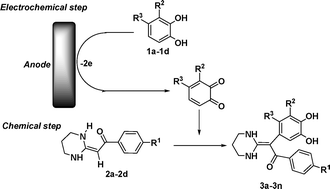Anodic oxidation of catechols in the presence of α-oxoketene N,N-acetals with a tetrahydropyrimidine ring: selective α-arylation reaction†
Abstract
The electrochemical

* Corresponding authors
a
College of Life Science & Bioengineering, Beijing University of Technology, Beijing, China
E-mail:
zengcc@bjut.edu.cn
Fax: 00 86 10-67392001
The electrochemical

 Please wait while we load your content...
Something went wrong. Try again?
Please wait while we load your content...
Something went wrong. Try again?
C. Zeng, D. Ping, L. Hu, X. Song and R. Zhong, Org. Biomol. Chem., 2010, 8, 2465 DOI: 10.1039/C001847C
To request permission to reproduce material from this article, please go to the Copyright Clearance Center request page.
If you are an author contributing to an RSC publication, you do not need to request permission provided correct acknowledgement is given.
If you are the author of this article, you do not need to request permission to reproduce figures and diagrams provided correct acknowledgement is given. If you want to reproduce the whole article in a third-party publication (excluding your thesis/dissertation for which permission is not required) please go to the Copyright Clearance Center request page.
Read more about how to correctly acknowledge RSC content.
 Fetching data from CrossRef.
Fetching data from CrossRef.
This may take some time to load.
Loading related content
